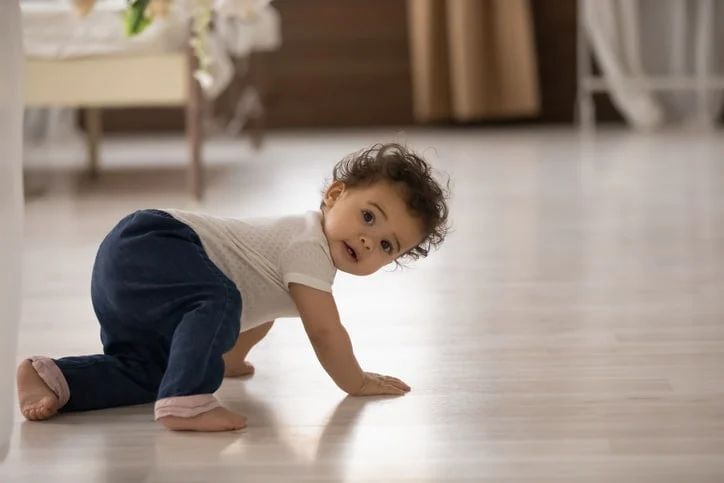
Crawling is one of the most exciting milestones in your baby’s development. It’s a sign that your baby is becoming more independent and curious about the world around them. But when do babies start crawling, and how can you help them learn this new skill? Here’s everything you need to know about crawling, from the average age and different styles to the signs of readiness and tips for encouragement.
What Age Do Babies Start to Crawl?
Most babies start to crawl between 7 months and 10 months old after they’ve learnt to sit up. Whilst the 9-month-old mark is the average age for little ones to crawl, it might take some babies longer to learn to crawl or they might skip the phase entirely and start pulling themselves up to learn how to walkhttps://www.motherandbaby.com/baby/development/when-do-babies-start-crawling/.
Some babies may start as early as 6 or 7 months, while others may take their sweet time putting four on the floorhttps://www.healthline.com/health/baby/when-do-babies-crawl. Some babies may even bypass crawling altogether and go straight from sitting up to standing and walkinghttps://www.healthline.com/health/baby/when-do-babies-crawl. This is nothing to worry about, as every baby is unique and develops at their own pace.
What Are the Different Types of Crawling Styles?
There are almost as many different ways for a baby to learn to crawl as there are babies. Your little one may start with one style and then progress to another, or stick with a favorite until they give up crawling for good. It’s all normal, and pretty adorable too! Here are some of the most common styles, according to the American Academy of Pediatricshttps://www.healthline.com/health/baby/when-do-babies-crawl:
Crawling speeds tend to vary too. Some babies are very fast crawlers, while some use crawling just to go a few incheshttps://www.whattoexpect.com/first-year/crawling/.
What Are the Signs That Your Baby Will Crawl Soon?
When your baby’s playing on the floor, you’re probably already keeping a close eye on the situation. Start watching for the most common signs that your baby’s getting ready to crawlhttps://www.healthline.com/health/baby/when-do-babies-crawl. One sign is when babies are able to roll from their stomachs to their backs and vice versa. Another sign of readiness is when your baby manages to get herself from her stomach up into a seated position by herself.
Some babies will get up on their hands and knees and rock back and forth, while you hold your breath and wait to see if they start moving forward. Others will scoot around on their bellies or backs before they figure out how to use their limbs more effectively.
How Can You Help Your Baby Learn to Crawl?
You can’t teach your baby how to crawl, but you can encourage them and make it easier for them to practice this new skill. Here are some tips for helping your baby learn to crawlhttps://www.healthline.com/health/baby/when-do-babies-crawlhttps://www.babycentre.co.uk/a6501/developmental-milestones-crawling:
Is Crawling a Developmental Milestone?
Crawling is not an official developmental milestone, according to the Centers for Disease Control and Prevention (CDC). This means that it’s not a skill that all babies must achieve by a certain age or in a certain way. Crawling is more of an intermediate step between sitting and walking, and it can vary widely among babies.
However, crawling is still an important skill that helps your baby develop their motor, cognitive, and social skills. Crawling allows your baby to explore their surroundings, learn about cause and effect, and interact with people and objects. Crawling also prepares your baby for the next stage of development: walking.
What If Your Baby Isn’t Crawling Yet?
If your baby isn’t crawling yet, don’t panic. As long as your baby is showing other signs of progress and meeting other milestones, such as sitting, rolling, reaching, grabbing, babbling, etc., there’s no need to worry. Some babies may take longer than others to crawl, or they may skip crawling altogether and go straight to walking.
However, if you notice any of the following red flags, you may want to talk to your pediatrician:
Your pediatrician can assess your baby’s development and check for any possible issues or delays. They may also refer you to a specialist or a therapist if needed.
How to Keep Your Crawling Baby Safe
Once your baby starts crawling, they will be able to reach places and things that were previously out of bounds. This means that you need to make sure that your home is safe and secure for your curious crawler. Here are some tips for keeping your crawling baby safehttps://www.healthline.com/health/baby/when-do-babies-crawlhttps://www.babycentre.co.uk/a6501/developmental-milestones-crawling:
Conclusion
Crawling is a wonderful milestone that marks a new stage in your baby’s development. It’s also a lot of fun for both you and your baby. By knowing when and how babies start crawling, what signs to look for, and how to help them along the way, you can make the most of this exciting time
Leave a comment